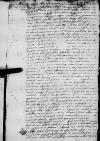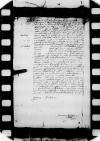List #2361
Ioannes DANTISCUS do Tiedemann GIESEHeilsberg (Lidzbark Warmiński), 1540-11-29
Regest polski:
Dantyszek zawiadamia Giesego, że z [Lidzbarka] odjechał kasztelan gdański [Achacy Cema], który dzień wcześniej powrócił z dworu królewskiego. Na prośbę Cemy Dantyszek opisuje pokrótce jego działania w Wilnie: [Królowa Bona] (Nostra) próbowała zapobiec kontaktom Cemy z biskupem chełmskim [podkanclerzym Samuelem Maciejowskim]. Mimo to Cema we wpółpracy z Maciejowskim przedstawił królowi [Zygmuntowi I] na osobności powierzone sobie sprawy. Król zaprobował sugestie radców pruskich dotyczące układu z królem rzymskim [Ferdynandem Habsburgiem] w kwestiach dotyczących księcia [Albrechta Hohenzollerna]. Monarcha wyjaśnił, że twardy ton jego poselstwa na ubiegły sejm pruski w Grudziądzu był skutkiem nalegań senatorów Królestwa, jednakże [senatorowie pruscy] mogą nań odpowiedzieć zgodnie z interesem swoich ziem. Maciejowski doradził Cemie, aby nie poruszał kwestii odsunięcia w czasie egzekucji podatku, ponieważ obawiał się, żeby nie przypisano tego pomysłu wyłącznie Dantyszkowi i Giesemu. Sugerował, że można tę sprawę załatwić inną drogą. W sprawie dotyczącej Radzyna (causa Redense) Maciejowski obiecał porozmawiać z królem bez świadków w dogodnym czasie, tak aby nie dowiedziała się [królowa] (Nostra). Król, chcąc okazać łaskawość Giesemu, nie sprzeciwił się powierzeniu burgrabstwa [gdańskiego] [Janowi] Stutte, skoro został on wpisany do dokumentu zwyczajowo wystawianego przez magistrat. W kwestii stypendiów w Lipsku król oczekuje odpowiedzialnego stanowiska [pruskich dostojników kościelnych]; nie życzy sobie, by ktokolwiek z Prus Królewskich wysyłany był tam na studia. Opaci obszernie usprawiedliwili się przed królem, rzecz została jednak odłożona do wspólnej narady. Król udzieli odpowiedzi na list z sejmu [pruskiego] w Grudziądzu, gdy tylko pozwoli mu zdrowie. Wkrótce kasztelan gdański opisze wszystko obszerniej, o wielu sprawach nie można jednak pisać ze względu na dworskie intrygi.
Dantyszek za jedyny znaczący sukces poselstwa Cemy uważa wiadomość, że nieprzychylne [sprawom pruskim] poselstwo na sejm w Grudziądzu nie wyszło z inicjatywy króla. Kasztelan nie osiągnął niczego w sprawie zboża, ponieważ przeszkodziła w tym [królowa]. Napisała także do Dantyszka, aby się jej nie przeciwstawiano. Dantyszek prosi, by adresat wpłynął na wojewodę pomorskiego, by ten powstrzymał swojego syna [Jerzego Konopackiego jr], który chce pozyskać zboże wbrew postanowieniu Rady [Pruskiej]. Sam Dantyszek również pisał w tej sprawie do wojewody pomorskiego, napominając go równocześnie, by porozmawiał ze szlachtą swojego powiatu o tym, żeby na kolejnym sejmie [pruskim] okazać wreszcie życzliwość podkanclerzemu [Samuelowi Maciejowskiemu].
Dantyszek przekazuje Giesemu nowiny o trudnej sytuacji na Węgrzech, gdzie trwają walki między możnymi, z których jedni popierają sułtana tureckiego, inni króla [Zygmunta], inni jeszcze – króla Ferdynanda. Królowa Izabela, odzyskawszy wiano, wraz z synem [Janem Zygmuntem] i fraucymerem opuściła Budę i udała się do zamku, wskazanego jej przez króla rzymskiego [Ferdynanda Habsburga]. Ferdynand utracił bardzo wielu żołnierzy podczas oblężenia pewnego Węgierskiego zamku.
Król [Zygmunt I] ma się nieco lepiej. Zajmuje go kwestia zgody między dysydentami, nakłania papieża [Pawła III] i innych władców do zwołania soboru.
Dantyszek przesyła Giesemu zawierający inne jeszcze nowiny list, otrzymany od zaufanego królowej, podkomorzego sieradzkiego Mikołaja Grabii. Obiecuje Giesemu wspierać jego sprawy.
| odebrano [1540]-12-01 Rękopiśmienne podstawy źródłowe:
| ||||||
Tekst + aparat krytyczny + komentarz Zwykły tekst Tekst + komentarz Tekst + aparat krytyczny Ekscerpty dotyczące podróży Dantyszka
Reverendissimo paper damaged⌈[everendissimo]everendissimo paper damaged⌉mo paper damaged⌈[o]o paper damaged⌉ patri et domino, domino paper damaged⌈[o]o paper damaged⌉
Reverendissime in Christo Pater et Domine, frater et amice carissime et honorande or honorandissime⌈honorandehonorande or honorandissime⌉.
Salutem et fraternam commendationem.
Rediit tandem
Consilium nostrum, quod ad tractatus cum serenissimo
Quod attingit duram illam legationem, quam n[u]p[er] or m[i]s[sam] paper damaged paper damaged⌈nu paper damaged⌈[u]u paper damaged⌉per paper damaged⌈[er]er paper damaged⌉n[u]p[er] or m[i]s[sam] paper damaged paper damaged⌉ in
De non exigenda hoc tempore paper damaged⌈[e]e paper damaged⌉ contributione, consuluit reverendissimus
Negotium Redense reverendissimus
In burgrabiatum pro domino
De stipendiis Lipcensibus adhuc est difficultas, nollet quidem
Ad eas litteras ex
Summatim haec utcumque attigi. Dominus
Ceterum, si nihil aliud ex hac per
Hungaricae res confusae sunt. Inter primores dissidiae hidden by binding⌈[iae]iae hidden by binding⌉, digla(dia)t(i)o(n)es, nulla, ut gentis natura est, fides. Sunt, qui ad hidden by binding⌈[d]d hidden by binding⌉
Serenissimus
Alia, quae mihi dominus succamerarius Siradiensis
Quod reliquum est, Dominationem Vestram Reverendissimam in rebus suis bene sperare iubeo. Iis si adminiculum meum prodesse potest, omnem polliceor operam, eandemque Dominationem Vestram Reverendissimam felicissime multis bonis annis valere meque ab illa fraterno amori complecti, in eoque commendatus haberi cupio ex animo.
Dat(ae) or Dat(um)⌈Dat(ae)Dat(ae) or Dat(um)⌉
Reverendissimae Dominationis Vestrae frater integerrimus



 BCz, 245, p. 230
BCz, 245, p. 230